Medford in Jackson County, Oregon — The American West (Northwest)
Medford Boomed As Orchards Bloomed
Promoters widely advertised the Rogue Valley as an agricultural Mecca, and Medford became one of the fastest growing cities in the United States. By 1910, there was such a housing shortage that a tent city grew up on the edge of town.
Medford’s burgeoning population and an infusion of capital from wealthy easterners transformed the modest town into a sophisticated metropolis. Between 1909 and 1911, many of Medford’s most impressive buildings, including Sacred Heart Hospital on the city’s developing east side, were erected. By 1912, Medford supported a high school, three elementary schools, a city park, a new passenger depot, and a Carnegie library. A roller-skating rink, indoor swimming pool, several movie theaters, and an opera house provided entertainment. Over 21 miles of wooden pipe brought mountain water to the city. Residents had electricity and telephone service. Hundreds of automobiles rumbled over 18 miles of paved streets. Fruit warehouses and packing sheds were built near the train yard, and Medford became the shipping and commercial center of the county. The economy was strong, Medford’s four banks prospered, and life was good until the Orchard Boom went bust.
By the mid-teens, Medford’s population sharply declined as a local recession engulfed the area. Down but not out, the resourceful community maintained a progressive spirit and rescued its shattered economy.
Despite the economic setbacks that came with the end of the Orchard Boom, Medfordites found ways to move ahead. Slow and steady growth revived Medford’s economy, and in 1927 the community celebrated its recovery with a “Jubilee of Visions Realized.” By then several irrigation districts provided water which, along with the formation of cooperatives, helped stabilize the orchard industry. In 1922, a fairgrounds with five exhibition buildings and tracks for auto, motorcycle, and horse racing opened on Medford’s south side. A dirt landing strip inside the racetrack was part of the first public airport in Oregon. In 1926, this airport became the first and only airmail stop in Oregon, ranking Medford as an early commercial aviation leader. The next year, Medford became the county seat, making it a governmental as well as an economic and transportation center.
Medford slid into the Great Depression along with the rest of the country in the 1930s. Unemployment rose, renewed growth halted, and one of its four banks failed. During this desperate time, a heated
political revolt resulted in stolen ballots from the new county courthouse and a constable’s murder. Yet Medford kept its face to the future. In 1930, the city dedicated a new state-of-the-art airport designed for larger passenger aircraft, and beginning in 1936 building owners used “New Deal” money to modernize. As smooth stucco and tile covered outmoded brick and stone ornamentation, progressive Medford enthusiastically adopted the streamlined architecture style of the era.
Erected by City of Medford; Southern Oregon Historical Society.
Topics. This historical marker is listed in these topic lists: Air & Space • Horticulture & Forestry • Industry & Commerce. A significant historical year for this entry is 1910.
Location. 42° 19.596′ N, 122° 52.309′ W. Marker is in Medford, Oregon, in Jackson County. Marker is on North Central Avenue south of East Main Street, on the left when traveling south. Touch for map. Marker is in this post office area: Medford OR 97501, United States of America. Touch for directions.
Other nearby markers. At least 8 other markers are within walking distance of this marker. A Town is Born (here, next to this marker); The War Brings Change (here, next to this marker); Cuthbert Building (about 300 feet away, measured in a direct line); Medford Auto Company Building (about 600 feet away); Historic Land Survey Monument
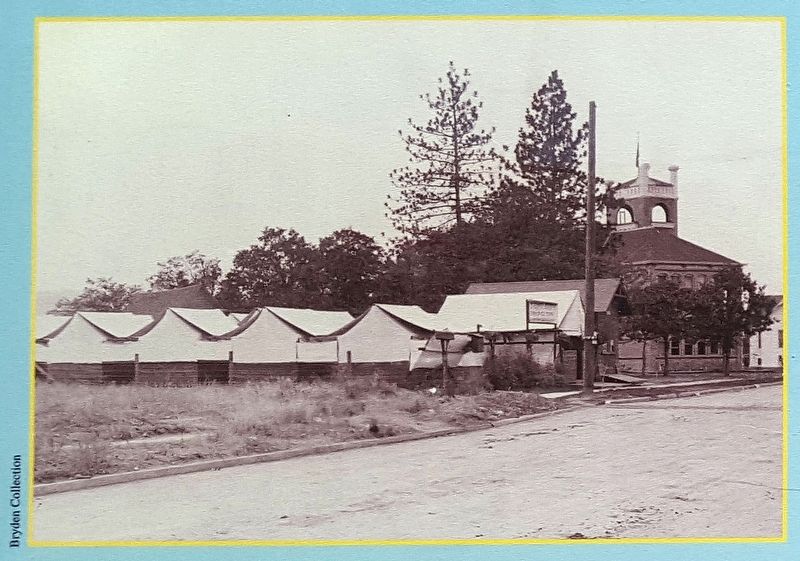
Photographed By Douglass Halvorsen, July 11, 2018
3. Medford Boomed As Orchards Bloomed Marker inset
A booming economy and a national advertising campaign drew a flood of newcomers to Medford early in the twentieth century. In 1910, a tent city was set up on South Oakdale Avenue behind Washington School to help meet the need for temporary housing. Furnished canvas tents featured electric lights, screen-ventilated sides and doors, and wood platform floors.
More about this marker. Marker is one of three mounted on the side of the historic Haskins Drug Store building and facing Vogel Plaza.
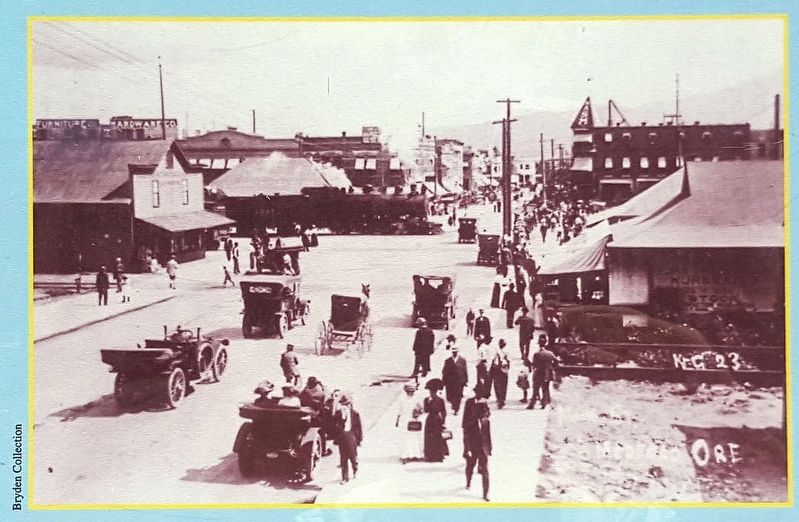
Photographed By Douglass Halvorsen, July 11, 2018
4. Medford Boomed As Orchards Bloomed Marker inset
Wealthy investors considered the motorcar essential for travel between their orchards and town. As a result, a 1909 Mail Tribune article reported that the city led the entire world in the number of automobiles per capita--one car for every 30 residents. In this 1911 photo, autos surround a lone buggy heading east on Main Street.

Photographed By Douglass Halvorsen, July 11, 2018
5. Medford Boomed As Orchards Bloomed Marker inset
During the frenzied real estate speculation of the early 1900s, many wealthy easterners immigrated to Medford and became western orchardists. Here, a group from this smart set is gathered in the Medford Hotel's elegant palm court. Built in 1911, the new hotel took the place of Front Street's aging Nash Hotel as the setting for lavish social events.
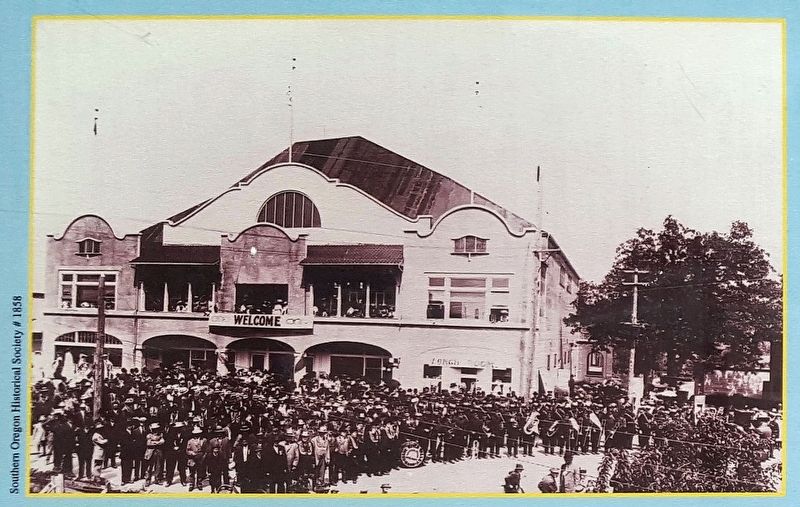
Photographed By Douglass Halvorsen, July 11, 2018
6. Medford Boomed As Orchards Bloomed Marker inset
Opened in July 1910, Medford's Natatorium was one of the community's many popular gathering spots. Until 1956, the mission style building remained on the east side of Riverside between 5th and 6th streets. This versatile recreation hall housed a large swimming pool, ice cream parlor, dance halls, movie theater, bowling alleys, shooting gallery, and other amusement.
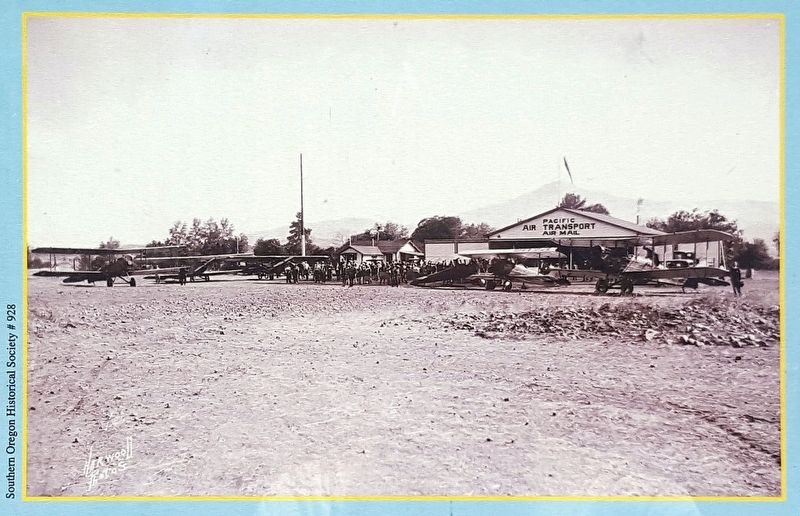
Photographed By Douglass Halvorsen, July 11, 2018
7. Medford Boomed As Orchards Bloomed Marker inset
Medford's first airport, established in 1922 at the county fairgrounds, today's South Gateway area, was also the first municipal airport in Oregon. When airmail service began in 1926, the site became a hub in Pacific Coast operations. This dirt airstrip served the city until 1930, when a new airport opened north of town.
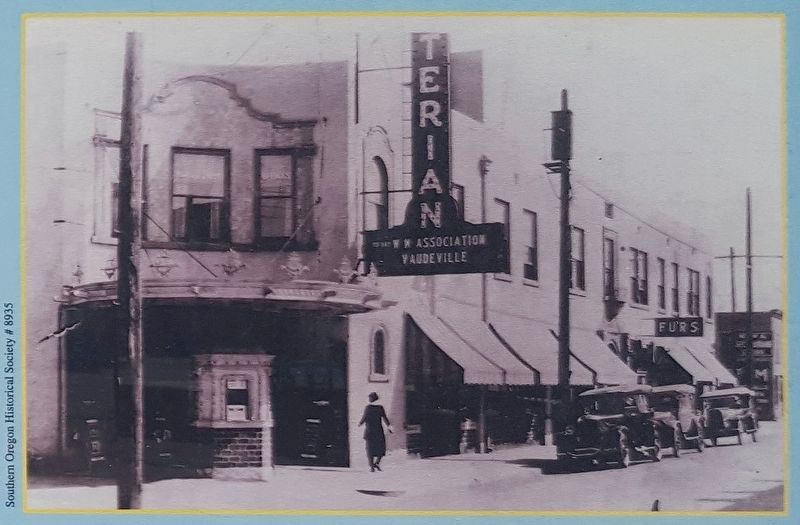
Photographed By Douglass Halvorsen, July 11, 2018
8. Medford Boomed As Orchards Bloomed Marker inset
When Hunt's Craterian opened in 1924, it had seating for 1,1187 people and presented motion pictures, live plays, and vaudeville acts. Six months later, fifteen-year-old Ginger Rogers danced across the stage. In 1928, America's first talking movie, "The Jazz Singer," played in this theater, and in 1929, air conditioning was installed for patron comfort.
Credits. This page was last revised on August 4, 2018. It was originally submitted on August 2, 2018, by Douglass Halvorsen of Klamath Falls, Oregon. This page has been viewed 363 times since then and 35 times this year. Photos: 1, 2, 3, 4, 5, 6, 7. submitted on August 2, 2018, by Douglass Halvorsen of Klamath Falls, Oregon. 8. submitted on August 3, 2018, by Douglass Halvorsen of Klamath Falls, Oregon. • Syd Whittle was the editor who published this page.

